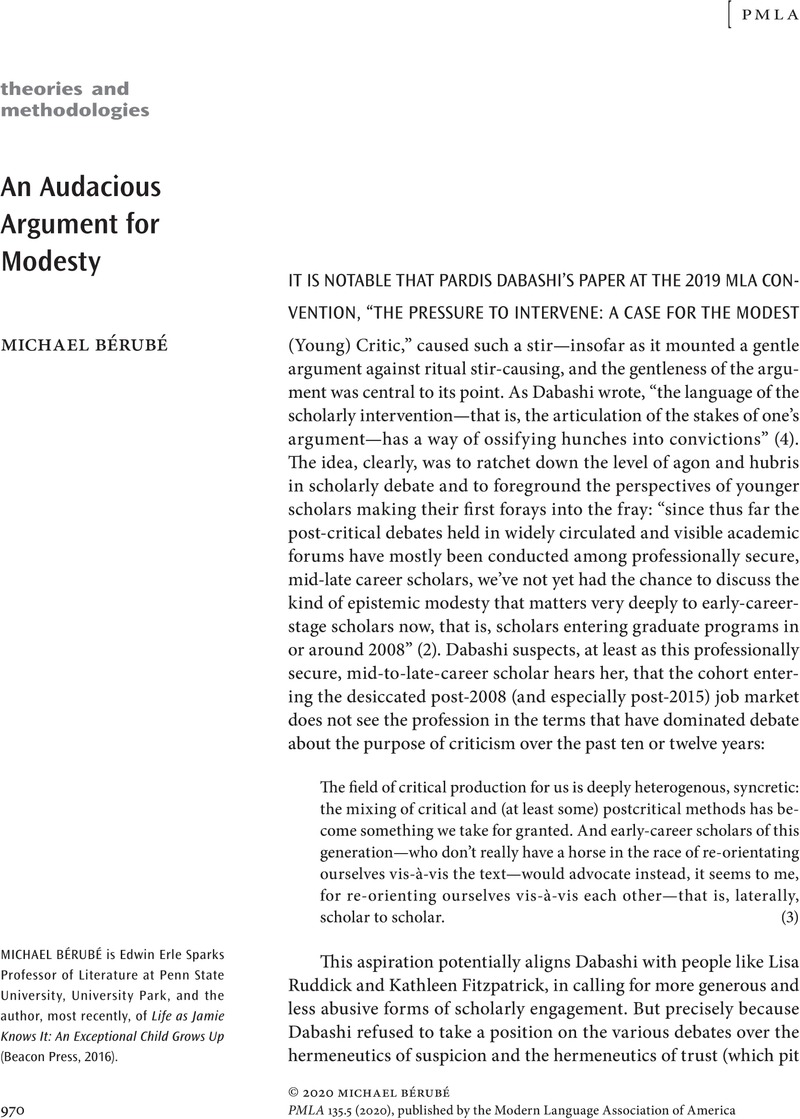No CrossRef data available.
Article contents
An Audacious Argument for Modesty
Published online by Cambridge University Press: 18 January 2021
Abstract
An abstract is not available for this content so a preview has been provided. Please use the Get access link above for information on how to access this content.

- Type
- Theories and Methodologies
- Information
- Copyright
- Copyright © 2020 Michael Bérubé
References
Works Cited
Anderson, Amanda. Psyche and Ethos: Moral Life after Psychology. Oxford UP, 2018.CrossRefGoogle Scholar
Apter, Emily, and Freedgood, Elaine. Afterword. The Way We Read Now, special issue of Representations, edited by Stephen Best and Sharon Marcus, vol. 108, no. 1, Fall 2009, pp. 139–46.CrossRefGoogle Scholar
Bersani, Leo. “Pynchon, Paranoia, and Literature.” Representations. vol. 25, 1989, pp. 99–118.CrossRefGoogle Scholar
Best, Stephen, and Marcus, Sharon. “Surface Reading: An Introduction.” The Way We Read Now, special issue of Representations, edited by Best and Marcus, vol. 108, no. 1, Fall 2009, pp. 1–21.CrossRefGoogle Scholar
Dabashi, Pardis. “The Pressure to Intervene: A Case for the Modest (Young) Critic.” Post-critique and the Profession. MLA Annual Convention, 4 Jan. 2019, Hyatt Regency, Chicago.Google Scholar
Fitzpatrick, Kathleen. Generous Thinking: A Radical Approach to Saving the University. Johns Hopkins UP, 2019.Google Scholar
Jagoda, Patrick. “Critique and Critical Making.” PMLA. vol. 132, no. 2, Mar. 2017, pp. 356–63.Google Scholar
Knapp, Steven, and Michaels, Walter Benn. “Against Theory.” Critical Inquiry. vol. 8, no. 4, 1982, pp. 724–42.CrossRefGoogle Scholar
Latour, Bruno. “Why Has Critique Run Out of Steam? From Matters of Fact to Matters of Concern.” Critical Inquiry. vol. 30, no. 2, 2004, pp. 225–48.CrossRefGoogle Scholar
Mitchell, W. J. T., editor. Against Theory: Literary Studies and the New Pragmatism. U of Chicago P, 1985.Google Scholar
Robbins, Bruce. “Critical Correctness.” The Chronicle of Higher Education, 12 Mar. 2019, www.chronicle.com/article/The-Neoliberal-Neutering-of/245874.Google Scholar
Ruddick, Lisa. “The Near Enemy of the Humanities Is Professionalism.” The Chronicle of Higher Education, 23 Nov. 2001, www.chronicle.com/article/The-Near-Enemy-of-the/15135.Google Scholar
Ruddick, Lisa. “Professional Harassment.” Critical Inquiry. vol. 26, no. 3, 2000, pp. 601–09.CrossRefGoogle Scholar
Ruddick, Lisa. “The Unnamed Work of English.” ADE Bulletin, no. 151, 2011, pp. 29–35, doi:10.1632/151.29.CrossRefGoogle Scholar
Sedgwick, Eve Kosofsky. “Paranoid Reading and Reparative Reading; or, You're So Paranoid, You Probably Think This Introduction Is about You.” Novel Gazing: Queer Readings in Fiction, Duke UP, 1997, pp. 1–37.CrossRefGoogle Scholar
Williams, Jeffrey. “The New Modesty in Literary Criticism.” The Chronicle of Higher Education, 5 Jan. 2015, www.chronicle.com/article/The-New-Modesty-in-Literary/150993.Google Scholar


